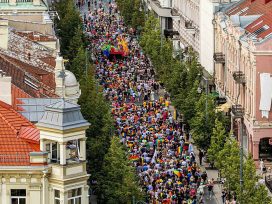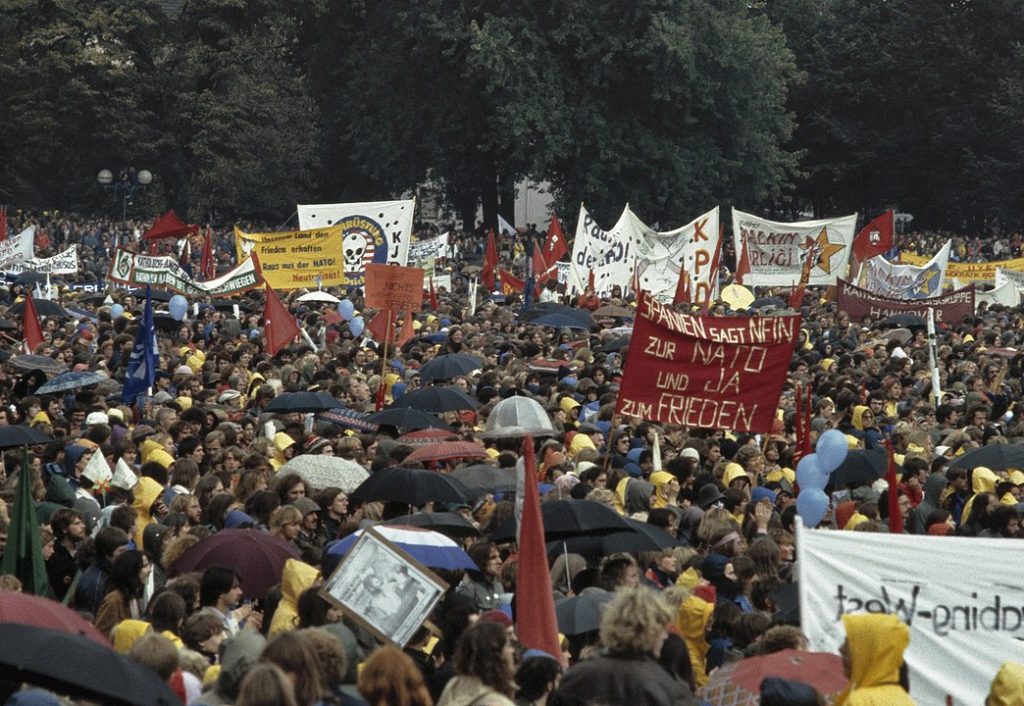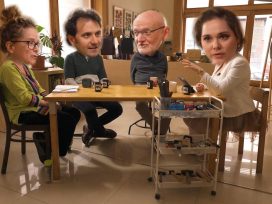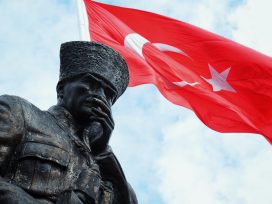It is thirty years since the 1989 revolutions and even today, the standard commentary suggests that there was nothing new about them, that they contained no new ideas. Jürgen Habermas noted, at the time, ‘a peculiar characteristic of this revolution, namely its total lack of ideas that are either innovative or oriented towards the future’. He described 1989 as the ‘rectifying’ revolution (nachholend, literally ‘catching up’). I want to suggest that this was quite wrong. There was something very new about the 1989 revolutions that profoundly affected the way the world is ordered. But what was new cannot easily be located at the national level. Rather, it had to do with a vision of Europe and the world – a new or reconstructed European Utopia from Below. It was a utopia that came out of the dialogue across the Cold War divide, between western European peace movements and the eastern European human rights movements.
It was this dialogue, I would argue, that created the context for the 1989 revolutions. It was by no means the first European Utopia from Below, nor the last. While my focus here is on the social struggles that preceded the 1989 revolutions, I will also say something about earlier utopias, something about what went wrong after 1989, and something about new and emerging Utopias from Below.
Democracy and disarmament
According to conservatives, Utopias are illusions that legitimize social engineering. Conservatives see themselves as pragmatic, in contrast to progressives, whom they regard as hopelessly idealistic. But progressive proposals for change can turn out to be more practical than staying the same, especially in moments of transition, when political institutions are out of step with broader economic and social developments.
To avoid the illusory nature of Utopia, Immanuel Wallerstein coined the term ‘utopistics’, by which he meant ‘the serious assessment of historical alternatives’ based on reasoned argument and judgement: ‘not the face of the perfect (and inevitable) but the face of an alternative better and historically possible (but far from certain) future’. I would argue that plausible utopistic proposals, which we might call utopian space, emerge out of collective debate and deliberation that is the stuff of social struggles. The originality of the ideas comes out of often deep and bitter arguments, as well as mutual communication and understanding. Their plausibility arises from their ability to mobilize popular support. These struggles produce collective knowledge, based on the contribution of numerous individuals and their exchanges.
The European Utopia from Below was what was ‘new’ about the 1989 revolutions. The 1980s were a period of widespread political mobilisation. A mass peace movement sprang up in western Europe in response to the decision by the Reagan administration to deploy a new, more usable generation of intermediate range missiles – the cruise and Pershing missiles – in the UK, West Germany, Italy, the Netherlands and elsewhere. Millions demonstrated in 1981 and 1983 and peace camps were set up at all the missile sites, the most famous being Greenham Common. This was the period of the ‘Second Cold War’, as my former colleague Fred Halliday described it – a return to the hostile rhetoric and displays of military might that many had believed were disappearing during the so-called détente in the 1970s.
In eastern Europe, the détente had also spawned new independent political groups, primarily as a consequence of the Helsinki Declaration of 1975. This was when eastern European governments signed up to what they thought were paper commitments to human rights in exchange for western commitments to preserve the territorial status quo and to co-operate in economic and cultural activities. These new groups included KOR in Poland (the committee in defence of workers and intellectuals), Charta 77 in Czechoslovakia, and the democratic opposition in Hungary.
I belonged to that part of the western European peace movements who saw ourselves not just as anti-nuclear movements but also as an anti-Cold war movements; we explicitly made a link between democracy and disarmament. We saw the Cold War as a sort of mutual enterprise or ‘virtual conflict’, in which the threat of nuclear war served as a disciplining mechanism in both halves of Europe. Yalta was not just a problem for our friends in the East; the ‘return to Europe’ was also relevant for us in the West. How could we call ourselves democratic when control over life and death was not even in the hands of our own politicians, but decided in Washington or Moscow? As György Konrád, the Hungarian writer put it: ‘The Soviet and American Presidents have more power than all the tyrants of history combined… I look at those two faces and I blanch. I wouldn’t entrust the fate of humanity to even Aristotle and Kant.’ How could nuclear weapons be used to defend human rights when their use would kill millions of people? Getting rid of nuclear weapons was to be achieved not by seizing power, but by changing the relations between state and society. Hence the need to link up with civic groups in eastern Europe. The END Appeal of 1980, largely drafted by the British historian E. P. Thompson, stated:
We must defend and extend the right of all citizens, East and West, to take part in this common movement and to engage in every kind of exchange …We must commence to act as if a united, neutral, pacific Europe already exists. We must learn to be loyal not to “East” or ‘West’ but to each other and must disregard the prohibitions and limitations imposed by any national state.
Peace activists in the West travelled to eastern Europe to make contacts with the new emerging dissident groups. There we discovered a whole new language that had been developed by eastern European intellectuals. At the time, the term civil society was hardly used except among Italian Communists. It was the Polish historian, Adam Michnik, who revived the term. In a famous essay entitled ‘The new evolutionism’, Michnik argued that violent attempts to overthrow the communist regimes would always fail because they were so strong militarily. Rather, the aim should be to change relations between state and society through opening up autonomous self-organised spaces, like the independent trade union Solidarnosc, or a ‘flying university’. Similarly, eastern and central Europeans used terms like ‘antipolitics’ and the ‘parallel polis’, based on an Aristotelian idea of the good.
Although this is widely neglected in accounts of what happened, they understood their project as a global project. György Konrád was the first to use the term globalisation, in his book Antipolitics, published in English in 1984. He talked about nuclear war as ‘global Auschwitz’. Václav Havel argued that the post-totalitarian system was ‘merely an extreme version of the global automatism of technological civilisation’. Traditional democracies were also victims, even though they were ‘manipulated in ways that are infinitely more subtle and refined than the brutal methods used in post-totalitarian societies’.
A new global discourse
The dialogue was not easy. There were arguments within the western peace movement, within the human rights movements, and between the peace movements and the human rights movements. Within the peace movements, there were debates about whether support for human rights could lead to peace. Some western peace activists were still linked to communist parties and some still perceived eastern Europe to be socialist, even if socialism had gone astray. Many believed in making peace with enemies, and engaging with official peace committees in eastern Europe, even though the latter were established to infiltrate the western European peace movement. And many were suspicious of human rights, because it was part of Cold War rhetoric and they feared that talk of human rights would play into justifications for the arms race.
These differences were mirrored in the East European human rights groups. Some believed that western military strength was the only way to achieve human rights and that peace activists were merely fellow travellers. These concerns were eloquently articulated by Václav Havel, in an essay addressed to the 1985 END Convention entitled ‘The Anatomy of Reticence’. But by the end of the decade, many in eastern Europe began to make the point that détente and disarmament could provide a context for opening up eastern Europe, while many in the western peace movement came to the view that the best way to end the arms race would be democracy in eastern Europe. At the END Convention in a church in Lund in 1987, E. P. Thompson publicly embraced Jacek Kuroń , one of the key democratic thinkers in Poland, in a symbolic coming together of peace and human rights. That same year, the treaty eliminating intermediate-range nuclear weapons (the INF Treaty) was signed as a consequence of peace movement pressure. This paved the way for a new détente, in which it became difficult to crack down on protest.
It was this debate, I would argue, that produced a new global discourse that combined peace and human rights, transnational civil society and humanitarianism. It animated the dramatic growth in multilateral peace operations, the thickening of rights-based international law, and the increasing role of global civil society in law and policy-making at a global level in the 1990s. It also propelled forward the European project (unfortunately, together with market fundamentalism). The idea of Europe as a peace project, which had of course been present in earlier periods, began to be widely articulated and intertwined with ideas about the EU’s external policy. This had to do with the spread of human rights and a global rule of law, rather than traditional geopolitics. It was as though the ‘inside’ of states characterised by law and politics was beginning to permeate the ‘outside’ characterised by war and diplomacy.
Blind spots
The peace movement of the 1980s was by no means the first European Utopia from Below. Ever since the term ‘Europe’ began to replace ‘Christendom’, philosophers and activists have put forward peace schemes involving the unification or federalisation of Europe. They include Erasmus, the Abbé de Saint-Pierre, William Penn, Jeremy Bentham and, of course, Immanuel Kant. What is less well-known are the numerous Peace Congresses that took place in Europe from the mid-nineteenth century. There were eleven Peace Congresses between 1843 and 1889 and 33 between 1889 and 1939. Victor Hugo was the president of the 1849 Congress in Paris, when he called for a United States of Europe. At the 1867 Peace Congress in Geneva, Garibaldi was made honorary president, despite objections from many peace activists who argued that ‘his only title to distinction are his war-like exploits’.
But perhaps the most significant European Utopia from Below was the Ventotene Manifesto, written on the island of Ventotene by a group of anti-fascists imprisoned there by Mussolini, including Altiero Spinelli. The Manifesto called for free united socialist Europe and was signed by members of the resistance across Europe. Their struggles undoubtedly contributed to the establishment of the European Coal and Steel Community, the forerunner of the European Union. Indeed, it is worth noting that many of the activists of the 1980s in both halves of Europe were the descendants of members of the European resistance.
The post-1989 liberal peace discourse had its heyday in the 1990s before being sidelined by the War on Terror and the return of geopolitics. Those involved in the dialogue had hoped that both NATO and the Warsaw pact would be dissolved and replaced by a new pan-European security system based on the Helsinki principles. But while the Warsaw Pact was broken up, NATO expanded. Perhaps even more importantly, both halves of Europe were engulfed by a wave of market fundamentalism.
Why did those of us who took part in the dialogue neglect the lessons of our parents’ generation, the signatories of the Ventotene manifesto, about the key importance of social justice? Was it because we thought those battles had been won, because we took the welfare state for granted? The ‘new social movements’ that developed after 1968 were much more preoccupied with the oppressive and militaristic nature of the state and with new issues like gender, the environment and peace. At the same time, a new breed of neoliberal ideology was emerging on the right, also reacting against the growing reach of the state. Unbeknownst to us, perhaps one of the reasons the 1989 revolutions were so peaceful was that communist apparatchiks saw an opportunity to exchange their political status for material wealth. Through privatisation and liberalisation, they were able to transform themselves into the new oligarchs.
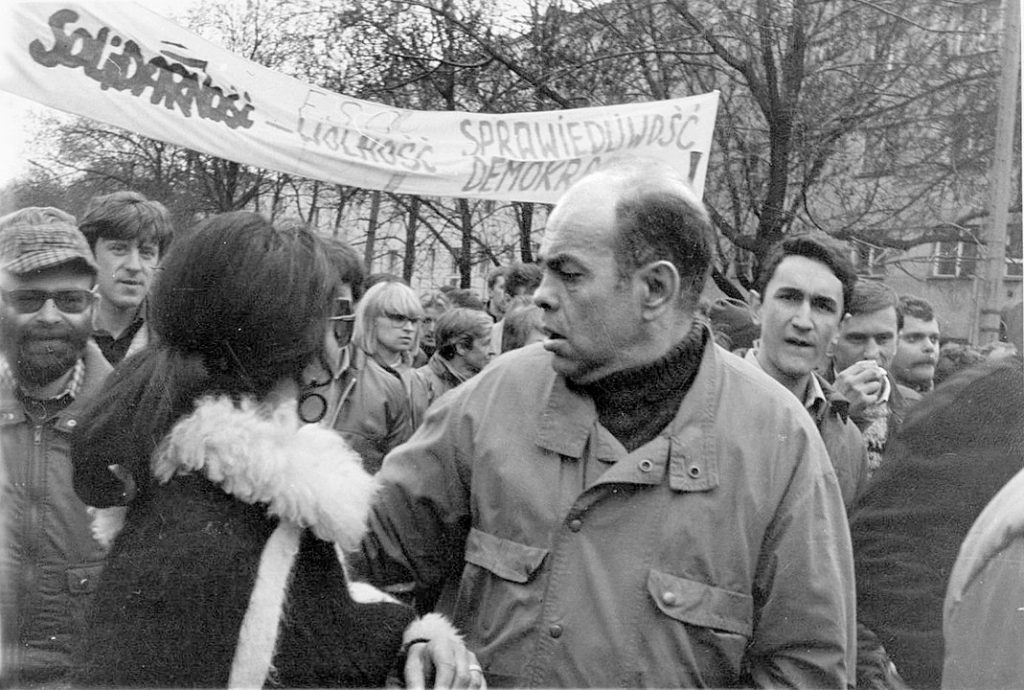
1 May 1989 demonstration with the participation of the opposition and Jacek Kuroń. Photo by Andrzej Iwański (Scanned by Europeana 1989) from Wikimedia Commons.
21st century utopistics
Today we are living through another of those historical transitions when utopistic ideas become plausible. The profound and pervasive distrust of political institutions that we now observe is the consequence of extreme inequality and four decades of neoliberalism and crony capitalism. Since 2000, new movements against untrammelled capitalism have emerged like the European Social Forum, Occupy, and new left parties like Syriza and Podemos. Climate change strikes and the Extinction Rebellion are drawing attention to the fragility of the natural world. And the need to counter the rise of rightwing populism, including Brexit, is generating a new debate about whether social and environmental justice require institutions beyond the state and about how to increase the democratic accountability of a new ‘thicker’ Europeanism and internationalism.
At the same time, many of the problems faced by the European Union have to do with the spread of conflict in places like Ukraine or Syria and the weakening of human rights norms, especially in relation to asylum seekers and immigrants. The anniversary of the 1989 revolutions reminds us that any new European Utopia from Below needs to address the problems of war and displacement that surround our continent.
History tends to be told from above and through the lens of the past, which tends to be a national lens. This is why the story of the political campaigns of 1980s has been forgotten, and why accounts of 1989 focus on what happened in individual states. I would like to end with a quotation from E. P. Thompson. It is not only said there were no new ideas in 1989, it is also widely asserted that no-one predicted the 1989 revolutions. Yet Thompson, the pioneer of history from below, wrote the following in 1982, in a lecture entitled ‘Beyond the Cold War’:
What we can glimpse now … is a détente of peoples rather states – a movement of peoples which sometimes dislodges states from their blocs and brings them into a new diplomacy of conciliation, which sometimes runs beneath state structures, and which sometimes defies the ideological and security structures of particular states … The Cold War road show, which each year enlarges, is now lurching towards its terminus. But in this moment changes have arisen in our continent, of scarcely more than one year’s growth, which signify a challenge to the Cold War itself. These are not ‘political’ changes in the usual sense. They cut through the flesh of politics down to the human bone … What I have proposed is improbable. But, if it commenced, it might gather pace with astonishing speed. There would not be decades of détente as the glaciers slowly melt. There would be rapid and unpredictable changes; nations would become unglued from their alliances; there would be sharp conflicts within nations; there would be successive risks. We could roll up the map of the Cold War and travel without maps for a while.
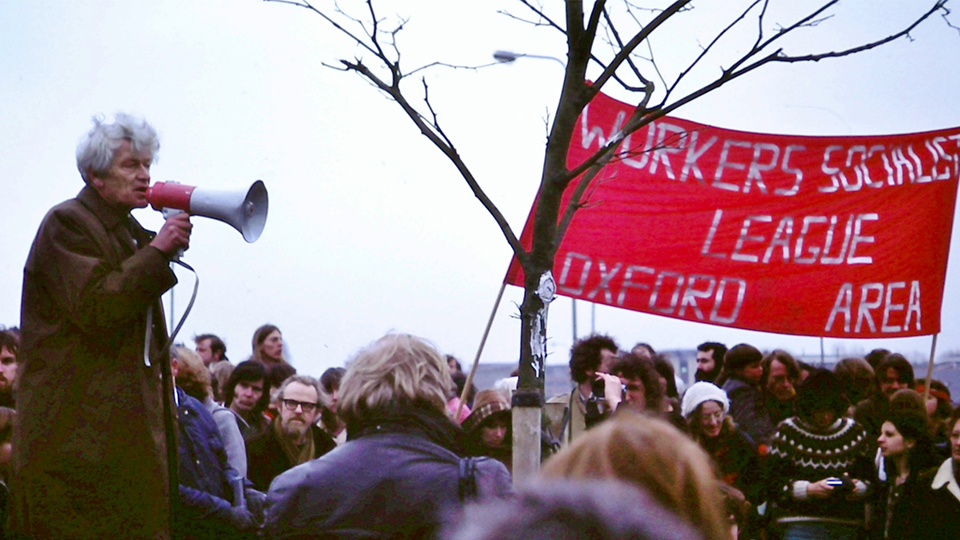
E. P. Thompson speaking to anti-nuclear weapons protesters in 1980. Photo by Kim Traynor from Wikimedia Commons.
We have travelled without maps for a while, but now we need a new utopistic vision. Those of us engaged in anti-Brexit, anti-austerity or climate change actions have the feeling that a new form of collective knowledge, one that could produce a new European Utopia from below, is in the process of construction.
This article is based on Mary Kaldor’s keynote speech at the Literatur im Herbst festival in Vienna on 22–24 November 2019. The title of the event was ‘Der utopische Raum’ / ‘The Utopian space’. Published in collaboration with the Alte Schmiede Kunstverein Wien.
